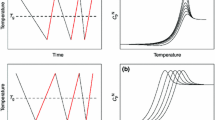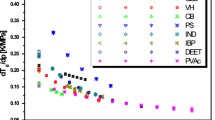Abstract
The applicability of the Kissinger equation for the evaluation of apparent activation energy corresponding to glass transition kinetics is examined. Theoretically simulated data based on the generally accepted Tool–Narayanaswamy–Moynihan model were used to represent relevant cases of structural relaxation behavior. The values of the apparent activation energy determined by the Kissinger equation were, despite the linearity of the dependencies, in major disagreement with the original values of ∆h * used for the simulation of the source data. Furthermore, a large dependence of the ∆h *Kis evaluation (performed using the Kissinger equation) on the thermal history of the glass was found. The latter represents an unacceptable systematic error in the methodology, implying the incorrectness of the Kissinger equation usage for the evaluation of “glass transition activation energy”. This study addresses the currently widespread (incorrect) usage of the Kissinger equation for the above-mentioned purpose.






Similar content being viewed by others
References
Douglas RW, Frank S. A history of glassmaking. London: Co. Ltd.; 2007.
Moody BE. The life of George Ravenscroft: an addendum. Glass Technol. 1989;30:191–200.
Cable M. Classical glass technology. In: Zarzycki J, editor. Materials science and technology 9. Weinheim: VCH; 1991.
Kovacs AJ, Aklonis JJ, Hutchinson JM, Ramos AR. Isobaric volume and enthalpy recovery of glasses. II. A transparent multiparameter theory. J Polym Sci B. 1979;17:1097–162.
Robertson RE, Simha R, Curro JG. Free-volume and the kinetics of aging of polymer glasses. Macromolecules. 1984;17:911–9.
Ngai KL. Universality of low-frequency fluctuation, dissipation and relaxation properties of condensed matter. I. Comments Solid State Phys. 1979;9:127–40.
Ngai KL. Universality of low-frequency fluctuation, dissipation and relaxation properties of condensed matter. II. Comments Solid State Phys. 1980;9:141–55.
Ngai KL, Rendell RW, Rajagopal AK, Teitler S. Three coupled relations for relaxations in complex systems. Ann NY Acad Sci. 1986;484:150–84.
Hodge IM. Adam-Gibbs formulation of nonlinearity in glassy-state relaxations. Macromolecules. 1986;19:936–8.
Narayanaswamy OS. Model of structural relaxation in glass. J Am Ceram Soc. 1971;54:491–8.
Moynihan CT, Easteal AJ, DeBolt MA, Tucker J. Dependence of fictive temperature of glass on cooling rate. J Am Ceram Soc. 1976;59:12–6.
Tool AQ. Relation between inelastic deformability and thermal expansion of glass in its annealing range. J Am Ceram Soc. 1946;29:240–53.
Patel AT, Pratap A. Study of kinetics of glass transition of metallic glasses. J Therm Anal Calorim. 2012;110:567–71.
Kumar R, Sharma P, Rangra VS. Kinetic studies of bulk Se92Te8-xSnx (x = 0, 1, 2, 3, 4 and 5) semiconducting glasses by DSC technique. J Therm Anal Calorim. 2012;109:177–81.
Kissinger HE. Reaction kinetics in differential thermal analysis. Anal Chem. 1957;29:1702–6.
Šesták J. Thermophysical properties of solids, their measurements and theoretical analysis. Amsterdam: Elsevier; 1984.
Hodge IM, Berens AR. Effects of annealing and prior history on enthalpy relaxation in glassy polymers. 2. Mathematical modeling. Macromolecules. 1982;15:762–70.
Svoboda R, Pustková P, Málek J. Relaxation behavior of glassy selenium. J Phys Chem Sol. 2007;68:850–4.
Málek J, Svoboda R, Pustková P, Čičmanec P. Volume and enthalpy relaxation of a-Se in the glass transition region. J Non Cryst Sol. 2009;355:264–72.
Acknowledgements
This study was supported by the Czech Science Foundation under projects No. 106/10/P035 and No. P106/11/1152.
Author information
Authors and Affiliations
Corresponding author
Rights and permissions
About this article
Cite this article
Svoboda, R., Čičmanec, P. & Málek, J. Kissinger equation versus glass transition phenomenology. J Therm Anal Calorim 114, 285–293 (2013). https://doi.org/10.1007/s10973-012-2892-3
Received:
Accepted:
Published:
Issue Date:
DOI: https://doi.org/10.1007/s10973-012-2892-3




